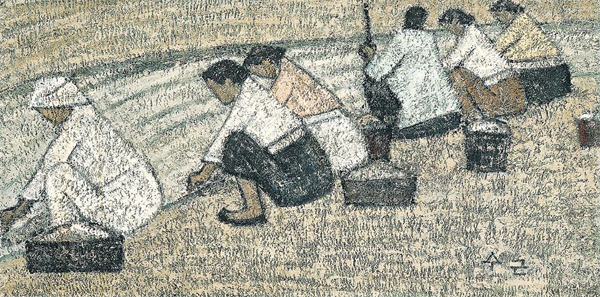Park Soo-keun getting largest-ever retrospective

“Washing Place” by Park Soo-keun (1914-65) is one of the 120 works on display at his largest-ever retrospective that starts on Friday at the Gana Insa Art Center in central Seoul. It is the most expensive Korean painting ever sold at a local auction. Provided by the gallery
About 120 works by Park, including oils, watercolors and drawings, will be on display at the gallery’s Insa-dong branch, the Gana Insa Art Center, in central Seoul.
“This will be a rare, large-scale show about Park, not only in the number of the oil paintings on display - 90 of the 350 oil paintings the artist left behind - but also in the amount of the archival materials being shown,” said Kyung Lee, executive director of Gana. The materials are on loan mainly from Kim Daljin Art Research and Consulting.
Among the paintings being shown is the famous “Washing Place,” the most expensive Korean painting ever sold at a local art auction. (The painting went for 4.52 billion won, or $4.27 million, at Gana’s affiliate Seoul Auction in 2007.)
“Washing Place” is famous not only for its high price but also for the hot legal disputes it created over allegations about its authenticity in 2008. The courts concluded in 2009 that the work presumably is a genuine Park painting.
Although Park’s works are valued now, he had difficulty selling them during his lifetime because the self-taught artist had a unique style, distant from his contemporaries who were heavily influenced by Western avant-garde artists.
The colors in Park’s works remind viewers of soil and stone, and the unique textures he developed have the feel of granite, the main material used for traditional Korean stone art. To create the texture, he applied heavy layers of oil paint again and again on each painting, a time-intensive endeavor.
“He truthfully depicted ordinary people’s everyday life in the most painful periods of Korean history,” said Lee Ho-jae, chairman of Gana Art.
Many of Park’s paintings depict female street vendors, showing how women had to work outside the home to support their families in the aftermath of the 1950-53 Korean War.
The artist’s son, Park Sung-nam, who is also a painter, told reporters, “When my parents went shopping, my father bought just one vegetable from one vendor and then bought another one from the next vendor.
“My mother asked him why and he answered, ‘If I bought everything from one vendor, the others would get disappointed.’ He was poor, but he always was concerned about the old women selling goods on the streets.”
Park’s paintings depicting those women are gloomy because of his colors and tones and his usually leafless trees. Still, there is a deeply human quality to the paintings as well.
The show runs from Jan. 17 to March 16. Admission is 10,000 won for adults. The gallery is open from 10 a.m. to 7 p.m., but closing time is extended to 9 p.m. on Wednesdays. Go to Anguk Station, line No. 3, exit No. 6 and walk for five minutes.
For details, call (02) 736-1020 or visit www.insaartcenter.com.
By Moon so-young [symoon@joongang.co.kr]










with the Korea JoongAng Daily
To write comments, please log in to one of the accounts.
Standards Board Policy (0/250자)